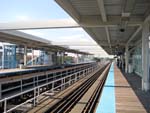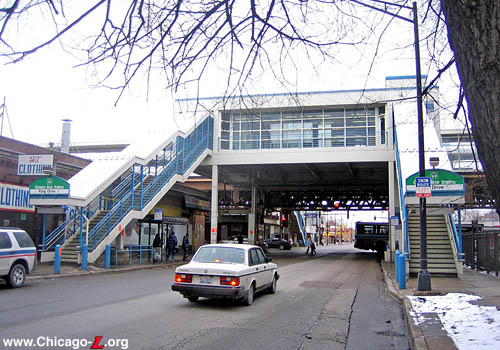
The King Drive station is
seen looking south on March 7, 2007 at the fare control
facility over the street. The station's boxy shape, use of
steel and glass, and vivid, contrasting colors give it an
almost postmodern look. The choice of blue was probably make
because at the time of its construction, Olympic Blue was
the CTA's official color for signage and other public
information elements, although the station is now on the
Green Line. For a larger view, click here.
(Photo by Graham
Garfield)
|
King Drive
(6300S/400E)
Martin Luther King Jr.
Drive and 63rd Street, Woodlawn
Service
Notes:

|
Green Line: East
63rd
|

|
Accessible
Station
|
Quick Facts:
Address: 400 E. 63rd
Street
Established: April 23, 1893
Original Line: South Side Rapid Transit
Previous Names: South Park Avenue
|
Skip-Stop Type:
|

|
Station
|
Rebuilt: 1991-93
Status: In Use
History:
South Park station -- the original name of King Drive station --
was built in 1892-93 when the South Side Rapid Transit Company
extended its line from 39th Street to Jackson
Park to serve the World's Columbian Exposition. South Park was
originally one of five stations on the Jackson
Park branch; the others were Stony
Island (aka Jackson Park), Dorchester,
University and Cottage
Grove.
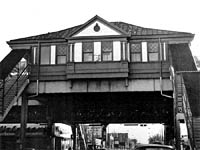
The historic, Colonial
Revival-influenced South Park station, looking south circa
1985. For a larger view, click here.
(Photo by Olga
Stefanos)
|
The station had two platform-level station houses, one in each
direction of travel. There was no connection between the two sides by
mezzanine or platform, so each station house handled passengers only
for one direction of travel.
The lineage of the station houses is somewhat uncertain. The
interesting pitch of the inbound station house's roof line as it
existed by 1930 suggests that the station was at some point remodeled
or reworked. (By this time, there was no outbound station house; it
is uncertain if there ever was one.) The original station house(s)
may have looked like Cottage Grove,
which was probably designed by Myron H. Church in 1892, and the
roof's shape certainly suggests this was possible. The design and
ornamental details on South Park station, as seen on the right, were
identical to those on the University
station a mile east, which would appear to establish a common
architect. Some have conjectured they were designed by William Gibb,
who also designed the original stations on the Northwestern Elevated
main line. The designs at South Park and at University
are very similar to Gibbs' work at Kinzie
on the Northwestern, which he designed in 1899. This station (and
University) features decorated
pilasters, large double-hung windows, bay windows and unique
ornamentation in the pediment, giving the structure a Colonial
Revival feel.
The station house interiors were clad in pressed metal and wood
trim, with wooden agent's booths and coal stoves for heat. Like most
of the Jackson Park
branch stations over 63rd Street, South Park had "turtleback"
arched platform canopies.
The World's Columbian Exposition of 1893, held in neighboring
Jackson Park, brought 20,000 new residents and entrepreneurs to
Woodlawn, the neighborhood in which South Park station was centrally
located, resulting in the construction of large apartments and
tourist hotels. Two decades later a long-time "L" trainman recalled that, "for a long time after the World's Fair the stations at South Park and University avenues were closed, as there was no traffic at those points."1 Both stations subsequently reopened as the neighborhoods around them developed and became more populated. The area around South Park station in particular remained a popular
destination thanks to the Washington Park's amusement parks,
racetrack, and beer gardens and the specialty shops along 63rd
Street. By the 1920s, Woodlawn had become one of Chicago's premier
retail and entertainment centers.
During the Depression, the community became distressed and the
mass migrations from the southern United States during World War II
for jobs in the defense industry reinforced a demographic
transformation already underway in Woodlawn. After the war, 63rd
Street's businesses began to close and in 1946 the Chicago Plan
Commission designated Woodlawn eligible as a conservation area. By
1960 Woodlawn had deteriorating, crowded housing and few commercial
attractions to support its population, which was by that time 89
percent African-American.
In 1968, South Park Boulevard was renamed for slain civil rights
leader Dr. Martin Luther King, Jr. The station the station followed
suit effective July 31, 1968.
In 1970, King Drive became one of a few that were designated as
allowing inbound boarding only. (A similar arrangement was put in
place at the same time at Cottage
Grove and University on the
Jackson Park
branch and Isabella on the Evanston
Line.) The agents booth and fare controls on the outbound side
were abandoned and removed, respectively, and high-barrier rotogates
were installed so that people could exit here, but not enter from the
unpaid area. Relatively few people were boarding the "L" to travel
eastbound from here and the few who needed to head that way could
take the #63 63rd bus, so the elimination of agents here allowed for
an economy for the CTA .
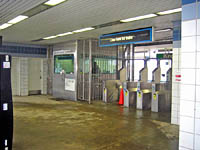
The fare control area of the
King Drive station is seen looking southeast on March 7,
2007. The stainless steel agent's booth and fare controls,
with its rounded corners and red stripes, is similar to in
style to other stations designed in the 1980s. For a larger
view, click here.
(Photo by Graham
Garfield)
|
On March 4, 1982, service on the Jackson
Park branch was suspended south of 61st
Street due to structural defects found in the Dorchester bridge
over the Illinois Central Railroad. The Chicago Department of
Transportation come up with a number of responses, which included
cutting service to Dorchester on the west side of the IC tracks,
abandoning the Jackson
Park branch altogether, and replacing the IC bridge and restoring
service to the Stony Island terminal,
the latter of which Mayor Byrne supported. On December 12, 1982,
service was restored as far as University
station and the defective bridge was later demolished. As part of the
reopening of the branch, then-Mayor Jane Byrne announced a four-point
program that included working closely with the Woodlawn community and
The Woodlawn Organization (TWO) to promote economic development along
East 63rd Street. The plan pledged $56 million for modernizing the
branch and the three reopened stations and to build a new Jackson
Park branch terminal at Dorchester,
providing direct access to the Illinois Central commuter line and a
CTA bus terminal.
The Jackson Park rehabilitation project was initiated in 1989 when
Cottage Grove station was closed for
reconstruction, reopening in 1991. On December 1, 1991, King Drive
closed and was demolished. The #3 King Drive bus was rerouted to
serve Garfield station during
construction. The station was reconstructed, replaced with a new
steel, glass and tile facility. Extra-wide stairs led from both side
of King Drive, north of 63rd Street, to the platform-level fare
control area, enclosed by a steel framed, modern station house with
glass curtain walls. An elevator provides access for the
mobility-limited. The agent's booths and fare controls were stainless
steel, with rounded corners and openings, similar in style to those
designed in the 1980s for several "L" stations such as O'Hare
and the Clark/Lake entrance in the 203
N. LaSalle Building. A full-width canopy stretches across both side
platforms, with an opening down the middle over the former location
of a center track. King Drive continued to be an "inbound only
boarding" station and the new facility was built with this in mind.
Fare controls are only provided on the inbound side. On the outbound
platform, only high-barrier rotogates are provided to allow exiting;
there is not way to access this platform from the unpaid area.
Another elevator and two stairs provided egress to the street from
the outbound platform.
The station was reopened on October 31, 1993, the same day the
Orange Line began
service. The construction was performed by the Chicago Department of Public Works.
The loss of this station and the ones at Cottage
Grove and University leave none of
the Jackson Park
branch's original 1893 stations in place.
The new King Drive station was open less than one year before the
Green Line -- the
realignment of the Jackson
Park and Englewood
branches with the Lake
branch, effective in 1993 -- closed for rehabilitation in January
1994. The station reopened in May 1996 when the Jackson
Park branch was reactivated after a general renovation of the
Green Line, although
little was done to King Drive since it had so recently been
rebuilt.
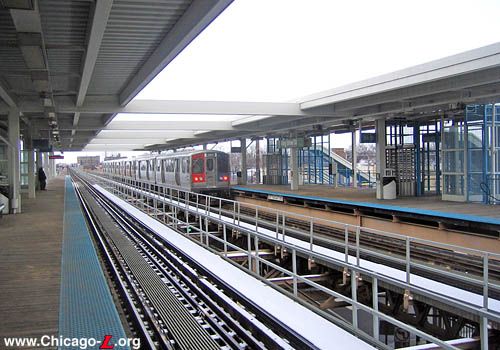
The King Drive station is
seen looking east from the inbound platform on March 7, 2007
as an outbound East 63rd Green Line train departs the
station. The outbound platform, on the right, is exit only,
with egress through the rotogates visible on the platform.
There are no turnstiles on that side. For a larger view,
click here.
(Photo by Graham
Garfield)
|

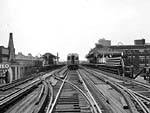
|
kingdrive02.jpg
(83k)
South Park station is seen looking west from the
center track on the Jackson
Park branch in Spring 1964. Visible in the distance are
the station's old South Side Rapid Transit "turtleback"
canopies and the old inbound station house on the right.
Note the absence of a station house on the left, although
the station house still allows outbound boarding at this
point. The train in the distance is stored on the center
track. (CTA Photo)
|

|
kingdrive06.jpg
(148k)
The stairway from the west side of King Drive to the station
house is seen looking south on March 7, 2007. Note the
bollards on the left to stop any errant cars from hitting
the stairs. King Drive and Cottage
Grove, which features a similar but larger design, both
feature these unusual arched station entrance signs, shaped
unlike any others on the system. (Photo by
Graham Garfield)
|
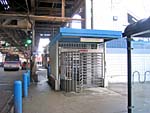
|
kingdrive07.jpg
(158k)
King Drive was rebuilt as an ADA-accessible station,
including egress from the outbound platform. But if the
station allows inbound boarding only, and there are no
turnstiles or station personnel on the outbound side, how do
you provide elevator egress and still restrict entrance to
the outbound side? Special wheelchair-accessible exit
rotogates! Installed on here and at Cottage
Grove, these unique rotogates -- King Drive's seen here
looking east on March 7, 2007 -- are large enough for a
wheelchair to fit through but still restrict entering access
to the outbound platform's elevator. (Photo
by Graham Garfield)
|
|
kingdrive08.jpg (168k)
The King Drive platforms are seen looking west on September 18, 2009. The platforms and canopy are typical of such structures built for the "L" in the 1980s and '90s, constructed of white-painted steel with a simple and functional design and aesthetic. The canopy roofing extends to the centerline of each track but leaves the center open, both for natural light and to reduce maintenance. (Photo by Graham Garfield) |
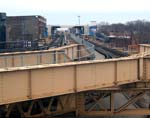 |
ROW@Calumet-63rd01.jpg (268k)
King Drive station is seen looking east where the East 63rd branch turns from its north-south alignment along Calumet to running over 63rd Street, wrapping around 61st Yard. This view looks from the ramp down to Lower 63rd Yard on March 28, 2010. (Photo by Dennis Herbuth) |


Notes:
1. "Reminiscences of an "L" Trainman." The Elevated News. 1920 February, p. 10.










